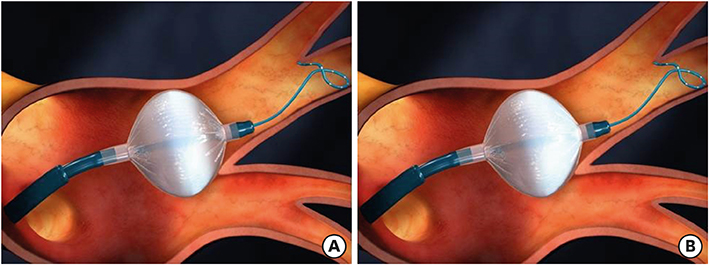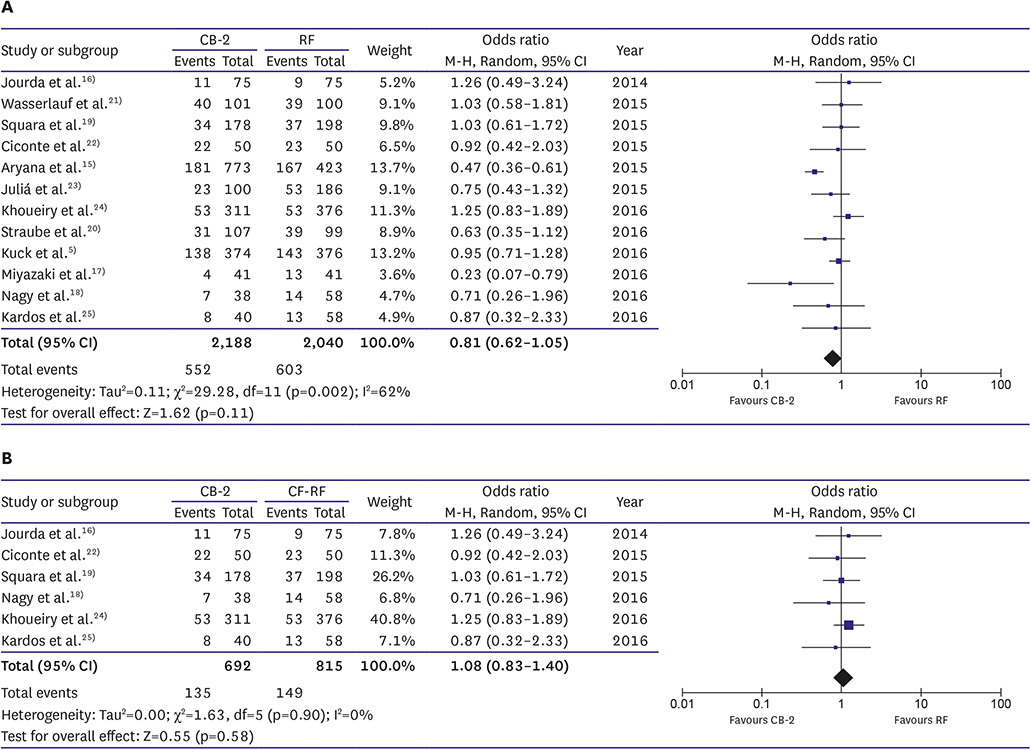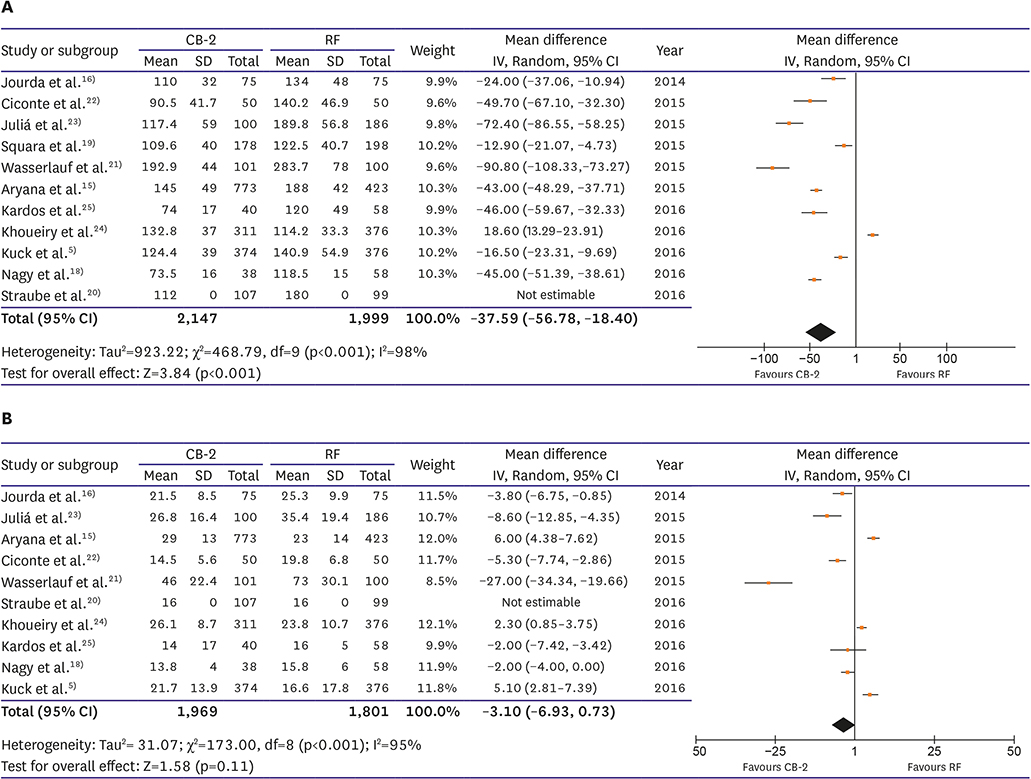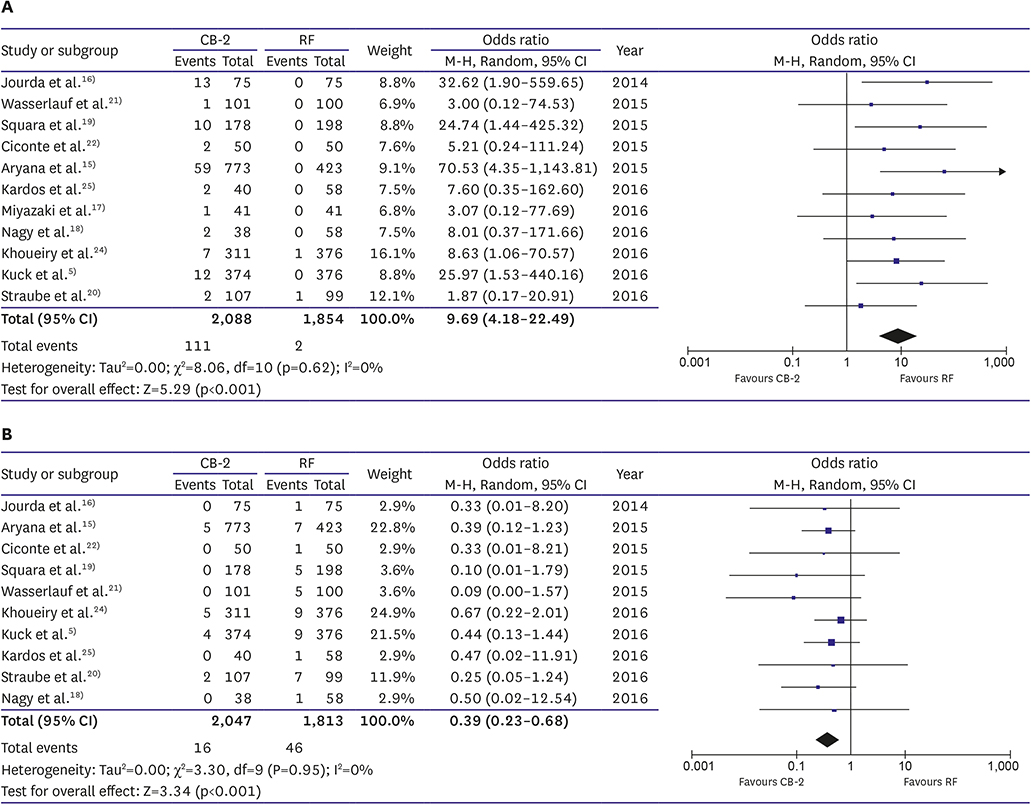Korean Circ J.
2018 Feb;48(2):114-123. 10.4070/kcj.2017.0318.
Cryoballoon Ablation for Atrial Fibrillation: a Comprehensive Review and Practice Guide
- Affiliations
-
- 1Cardiovascular Center, Kyung Hee University Hospital at Gangdong, Kyung Hee University, Seoul, Korea.
- 2Division of Cardiovascular Medicine, Stanford University School of Medicine, Stanford, CA, USA. pjwang@stanford.edu
- KMID: 2403159
- DOI: http://doi.org/10.4070/kcj.2017.0318
Abstract
- The cryoballoon was invented to achieve circumferential pulmonary vein isolation more efficiently to compliment the shortcomings of point-by-point ablation by radiofrequency ablation (RFA). Its efficacy and safety were shown to be comparable to those of RFA, and the clinical outcomes have improved with the second-generation cryoballoon. The basic biophysics, implemental techniques, procedural recommendations, clinical outcomes, and complications of the cryoballoon are presented in this practical and systematic review.
Keyword
Figure
Reference
-
1. Calkins H, Kuck KH, Cappato R, et al. 2012 HRS/EHRA/ECAS expert consensus statement on catheter and surgical ablation of atrial fibrillation: recommendations for patient selection, procedural techniques, patient management and follow-up, definitions, endpoints, and research trial design: a report of the Heart Rhythm Society (HRS) Task Force on Catheter and Surgical Ablation of Atrial Fibrillation. Developed in partnership with the European Heart Rhythm Association (EHRA), a registered branch of the European Society of Cardiology (ESC) and the European Cardiac Arrhythmia Society (ECAS); and in collaboration with the American College of Cardiology (ACC), American Heart Association (AHA), the Asia Pacific Heart Rhythm Society (APHRS), and the Society of Thoracic Surgeons (STS). Endorsed by the governing bodies of the American College of Cardiology Foundation, the American Heart Association, the European Cardiac Arrhythmia Society, the European Heart Rhythm Association, the Society of Thoracic Surgeons, the Asia Pacific Heart Rhythm Society, and the Heart Rhythm Society. Heart Rhythm. 2012; 9:632–696.e21.2. Haïssaguerre M, Jaïs P, Shah DC, et al. Spontaneous initiation of atrial fibrillation by ectopic beats originating in the pulmonary veins. N Engl J Med. 1998; 339:659–666.
Article3. Verma A, Jiang CY, Betts TR, et al. Approaches to catheter ablation for persistent atrial fibrillation. N Engl J Med. 2015; 372:1812–1822.
Article4. Gallagher JJ, Anderson RW, Kasell J, et al. Cryoablation of drug-resistant ventricular tachycardia in a patient with a variant of scleroderma. Circulation. 1978; 57:190–197.
Article5. Kuck KH, Brugada J, Fürnkranz A, et al. Cryoballoon or radiofrequency ablation for paroxysmal atrial fibrillation. N Engl J Med. 2016; 374:2235–2245.
Article6. Whittaker DK. Mechanisms of tissue destruction following cryosurgery. Ann R Coll Surg Engl. 1984; 66:313–318.7. Kaszala K, Ellenbogen KA. Biophysics of the second-generation cryoballoon: cryobiology of the big freeze. Circ Arrhythm Electrophysiol. 2015; 8:15–17.8. Andrade JG, Dubuc M, Guerra PG, et al. The biophysics and biomechanics of cryoballoon ablation. Pacing Clin Electrophysiol. 2012; 35:1162–1168.
Article9. Metzner A, Wissner E, Lin T, Ouyang F, Kuck KH. Balloon devices for atrial fibrillation therapy. Arrhythm Electrophysiol Rev. 2015; 4:58–61.
Article10. Metzner A, Reissmann B, Rausch P, et al. One-year clinical outcome after pulmonary vein isolation using the second-generation 28-mm cryoballoon. Circ Arrhythm Electrophysiol. 2014; 7:288–292.
Article11. Casado-Arroyo R, Chierchia GB, Conte G, et al. Phrenic nerve paralysis during cryoballoon ablation for atrial fibrillation: a comparison between the first- and second-generation balloon. Heart Rhythm. 2013; 10:1318–1324.
Article12. Di Giovanni G, Wauters K, Chierchia GB, et al. One-year follow-up after single procedure cryoballoon ablation: a comparison between the first and second generation balloon. J Cardiovasc Electrophysiol. 2014; 25:834–839.
Article13. Straube F, Dorwarth U, Schmidt M, Wankerl M, Ebersberger U, Hoffmann E. Comparison of the first and second cryoballoon: high-volume single-center safety and efficacy analysis. Circ Arrhythm Electrophysiol. 2014; 7:293–299.14. Kimura M, Sasaki S, Owada S, et al. Comparison of lesion formation between contact force-guided and non-guided circumferential pulmonary vein isolation: a prospective, randomized study. Heart Rhythm. 2014; 11:984–991.
Article15. Aryana A, Bowers MR, O'Neill PG. Outcomes of cryoballoon ablation of atrial fibrillation: a comprehensive review. J Atr Fibrillation. 2015; 8:1231.16. Jourda F, Providencia R, Marijon E, et al. Contact-force guided radiofrequency vs. second-generation balloon cryotherapy for pulmonary vein isolation in patients with paroxysmal atrial fibrillation-a prospective evaluation. Europace. 2015; 17:225–231.
Article17. Miyazaki S, Kuroi A, Hachiya H, et al. Early recurrence after pulmonary vein isolation of paroxysmal atrial fibrillation with different ablation technologies - prospective comparison of radiofrequency vs. second-generation cryoballoon ablation. Circ J. 2016; 80:346–353.18. Nagy Z, Kis Z, Som Z, Földesi C, Kardos A. Catheter ablation for paroxysmal atrial fibrillation: new generation cryoballoon or contact force sensing radiofrequency ablation? Orv Hetil. 2016; 157:849–854.19. Squara F, Zhao A, Marijon E, et al. Comparison between radiofrequency with contact force-sensing and second-generation cryoballoon for paroxysmal atrial fibrillation catheter ablation: a multicentre European evaluation. Europace. 2015; 17:718–724.
Article20. Straube F, Dorwarth U, Ammar-Busch S, et al. First-line catheter ablation of paroxysmal atrial fibrillation: outcome of radiofrequency vs. cryoballoon pulmonary vein isolation. Europace. 2016; 18:368–375.
Article21. Wasserlauf J, Pelchovitz DJ, Rhyner J, et al. Cryoballoon versus radiofrequency catheter ablation for paroxysmal atrial fibrillation. Pacing Clin Electrophysiol. 2015; 38:483–489.
Article22. Ciconte G, Baltogiannis G, de Asmundis C, et al. Circumferential pulmonary vein isolation as index procedure for persistent atrial fibrillation: a comparison between radiofrequency catheter ablation and second-generation cryoballoon ablation. Europace. 2015; 17:559–565.
Article23. Juliá J, Chierchia GB, de Asmundis C, et al. Regular atrial tachycardias following pulmonary vein isolation for paroxysmal atrial fibrillation: a retrospective comparison between the cryoballoon and conventional focal tip radiofrequency techniques. J Interv Card Electrophysiol. 2015; 42:161–169.
Article24. Khoueiry Z, Albenque JP, Providencia R, et al. Outcomes after cryoablation vs. radiofrequency in patients with paroxysmal atrial fibrillation: impact of pulmonary veins anatomy. Europace. 2016; 18:1343–1351.
Article25. Kardos A, Kis Z, Som Z, Nagy Z, Foldesi C. Two-year follow-up after contact force sensing radiofrequency catheter and second-generation cryoballoon ablation for paroxysmal atrial fibrillation: a comparative single centre study. BioMed Res Int. 2016; 2016:6495753.
Article26. Lakhani M, Saiful F, Parikh V, Goyal N, Bekheit S, Kowalski M. Recordings of diaphragmatic electromyograms during cryoballoon ablation for atrial fibrillation accurately predict phrenic nerve injury. Heart Rhythm. 2014; 11:369–374.
Article27. Mondésert B, Andrade JG, Khairy P, et al. Clinical experience with a novel electromyographic approach to preventing phrenic nerve injury during cryoballoon ablation in atrial fibrillation. Circ Arrhythm Electrophysiol. 2014; 7:605–611.
Article28. Miyazaki S, Nakamura H, Taniguchi H, et al. Esophagus-related complications during second-generation cryoballoon ablation-insight from simultaneous esophageal temperature monitoring from 2 esophageal probes. J Cardiovasc Electrophysiol. 2016; 27:1038–1044.
Article29. Metzner A, Burchard A, Wohlmuth P, et al. Increased incidence of esophageal thermal lesions using the second-generation 28-mm cryoballoon. Circ Arrhythm Electrophysiol. 2013; 6:769–775.
Article
- Full Text Links
- Actions
-
Cited
- CITED
-
- Close
- Share
- Similar articles
-
- Cryoballoon or Radiofrequency Ablation for Paroxysmal Atrial Fibrillation
- Pulmonary veins isolation using cryoballoon and pulsed field ablation for atrial fibrillation: practical techniques in variable scenarios
- Utility of a new imaging system for displaying complex anatomy during AF ablation with cryoenergy
- A Case of Successful Ablation of Right-Sided Accessory Pathway during Atrial Fibrillation
- Is ICE-Guided Cryoballoon Ablation for Atrial Fibrillation a New Advancement?





